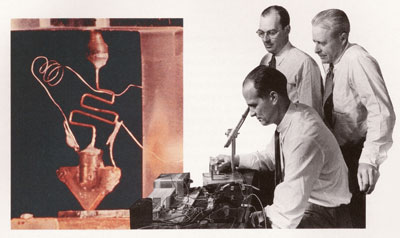
 |
Search | FAQ | US Titles | UK Titles | Memories | VaporWare | Digest | |||||||
| GuestBook | Classified | Chat | Products | Featured | Technical | Museum | ||||||||
| Downloads | Production | Fanfares | Music | Misc | Related | Contact | ||||||||
| CED in the History of Media Technology | ||||||||||||||

The first transistor was invented at Bell Laboratories on December 16, 1947 by William Shockley (seated at Brattain's laboratory bench), John Bardeen (left) and Walter Brattain (right). This was perhaps the most important electronics event of the 20th century, as it later made possible the integrated circuit and microprocessor that are the basis of modern electronics. Prior to the transistor the only alternative to its current regulation and switching functions (TRANSfer resISTOR) was the vacuum tube, which could only be miniaturized to a certain extent, and wasted a lot of energy in the form of heat. Although video was possible with vacuum tube equipment, as was the case with the Ampex VRX-1000, without the transistor video products would never have gotten very small.
The picture on the left above shows the first point contact transistor built by Walter Brattain. It consisted of a plastic triangle lightly suspended above a germanium crystal which itself was sitting on a metal plate attached to a voltage source. A strip of gold was wrapped around the point of the triangle with a tiny gap cut into the gold at the precise point it came in contact with the germanium crystal. The germanium acted as a semiconductor so that a small electric current entering on one side of the gold strip came out the other side as a proportionately amplified current.